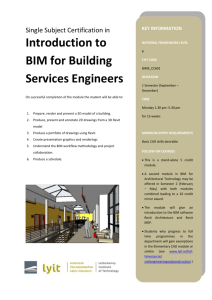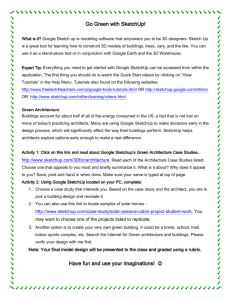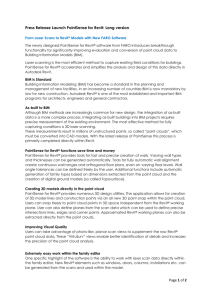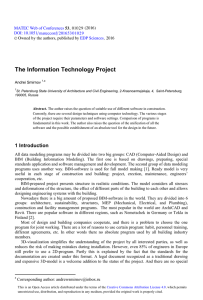TAR2033C Architectural Design
advertisement
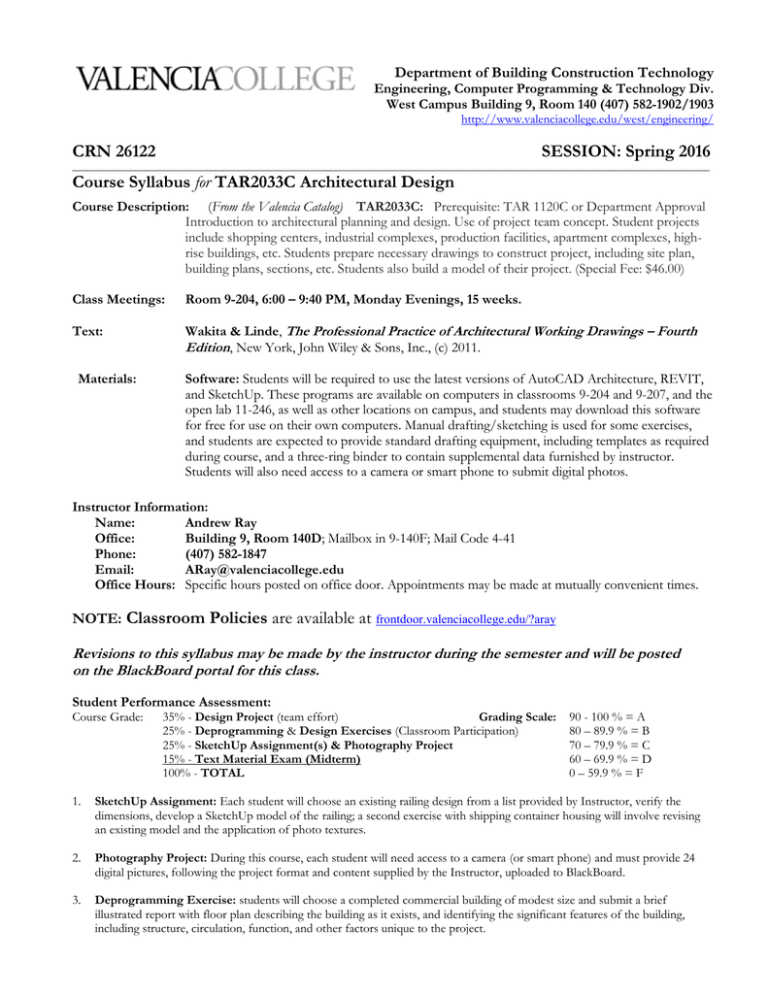
Department of Building Construction Technology Engineering, Computer Programming & Technology Div. West Campus Building 9, Room 140 (407) 582-1902/1903 http://www.valenciacollege.edu/west/engineering/ CRN 26122 SESSION: Spring 2016 _______________________________________________________________________________________________________________________________ Course Syllabus for TAR2033C Architectural Design Course Description: (From the Valencia Catalog) TAR2033C: Prerequisite: TAR 1120C or Department Approval Introduction to architectural planning and design. Use of project team concept. Student projects include shopping centers, industrial complexes, production facilities, apartment complexes, highrise buildings, etc. Students prepare necessary drawings to construct project, including site plan, building plans, sections, etc. Students also build a model of their project. (Special Fee: $46.00) Class Meetings: Room 9-204, 6:00 – 9:40 PM, Monday Evenings, 15 weeks. Text: Wakita & Linde, The Professional Practice of Architectural Working Drawings – Fourth Edition, New York, John Wiley & Sons, Inc., (c) 2011. Materials: Software: Students will be required to use the latest versions of AutoCAD Architecture, REVIT, and SketchUp. These programs are available on computers in classrooms 9-204 and 9-207, and the open lab 11-246, as well as other locations on campus, and students may download this software for free for use on their own computers. Manual drafting/sketching is used for some exercises, and students are expected to provide standard drafting equipment, including templates as required during course, and a three-ring binder to contain supplemental data furnished by instructor. Students will also need access to a camera or smart phone to submit digital photos. Instructor Information: Name: Andrew Ray Office: Building 9, Room 140D; Mailbox in 9-140F; Mail Code 4-41 Phone: (407) 582-1847 Email: ARay@valenciacollege.edu Office Hours: Specific hours posted on office door. Appointments may be made at mutually convenient times. NOTE: Classroom Policies are available at frontdoor.valenciacollege.edu/?aray Revisions to this syllabus may be made by the instructor during the semester and will be posted on the BlackBoard portal for this class. Student Performance Assessment: Course Grade: 35% - Design Project (team effort) Grading Scale: 25% - Deprogramming & Design Exercises (Classroom Participation) 25% - SketchUp Assignment(s) & Photography Project 15% - Text Material Exam (Midterm) 100% - TOTAL 90 - 100 % = A 80 – 89.9 % = B 70 – 79.9 % = C 60 – 69.9 % = D 0 – 59.9 % = F 1. SketchUp Assignment: Each student will choose an existing railing design from a list provided by Instructor, verify the dimensions, develop a SketchUp model of the railing; a second exercise with shipping container housing will involve revising an existing model and the application of photo textures. 2. Photography Project: During this course, each student will need access to a camera (or smart phone) and must provide 24 digital pictures, following the project format and content supplied by the Instructor, uploaded to BlackBoard. 3. Deprogramming Exercise: students will choose a completed commercial building of modest size and submit a brief illustrated report with floor plan describing the building as it exists, and identifying the significant features of the building, including structure, circulation, function, and other factors unique to the project. 4. Design Exercises: A variety of short-duration exercises will be assigned during the course, usually to be completed in class or by the following class period. These projects are intended to develop the design skills of the student and provide immediate feedback from the Instructor. Students missing an exercise must complete a make-up exercise, usually of increased difficulty, by the end of the class period one week after their return to class. 5. Design Project: Students will be divided into teams. Each team will select a building project to design and develop, from the concept phase to the completion phase. The project will be subject to guidelines set forth in various hand-outs, lectures, photos, movies and other data that may be used to supplement the text. Final presentation of the projects will be made to a panel of experts in design and construction; each team member will be responsible for presenting a portion of the project. A. The project will involve a Feasibility study; site location and building schematics must be “sold” to the instructor before proceeding. After approval, the team will develop their project. B. The project package will consist of the following: 1. Abbreviated Design Development sheets based on REVIT model file, including color presentation rendering. 2. Approximate estimate of total construction cost, including breakdown estimate of several items used in the building. 3. Complete index of materials used, with minimum (2) abbreviated specification sections. 4. A small-scale study model of building(s) and wall section model (built over scaled wall section drawing). 9. Final report, including percentage of participation by all team members. C. Three Major Milestones have been established in the development of your project. They are as follows: Phase 1: Feasibility study, site selection and schematic design sketches. Phase 2: Preliminary drawings and specifications. Phase 3: Completed project package, including drawings, documents, model(s) and rendering (optional) TAR2033C SPRING 2016 - TENTATIVE SCHEDULE Date Discussion Topics & Assignments Read: 1/11 Introductions; 1. Office Practices; contracts activity, intro to SketchUp in class 2. Drafting Standards; 3. BIM/Revit/SketchUp; Homework: SketchUp Tutorials & Deprogramming Assignment 1/18 1/25 MLK, Jr Holiday – COLLEGE CLOSED 4. Sustainable/Green Arch; Energy conservation activity 5. Construction Materials & Methods; Wall section sequence activity ADA & SketchUp project assignment Homework: photograph building(s), sketch plans 2/1 Design Phases; 6. Initial Prep for CD’s; 7. Site and Grading Plan; Site design exercise 14. Case study: One-story, conventional wood-framed residence 15 .Case study: Two-story, wood-framed residence with basement Review previous project drawings & models; assign teams Homework: Finish Deprogramming Report 8, 9 & 16 2/8 8. Floor Plan; 9. Foundation & Roof Plans, Framing Systems; Review team assignments; develop scope of projects & program 16. Case study: Steel and masonry 6-screen theater; bubble diagram exercise Homework: list of programmatic criteria 10, 11 & 17 2/15 Deprogramming Report Due 10. Building Sections; 11. Exterior & Interior Elevations; 17. Case study: Madison steel building; Exercise: cut section in REVIT and draw detail Design Assignment: each team member creates schematic design for project Schematic Designs Due; groups select schematic design for project 12. Schedules: Door, Window, & Finishes; 13. Architectural Details and Vertical Links 18. Case studies: Tenant improvements and Research Library; Review for Midterm 12, 13 & 18 2/22 2/29 Mid-Term Exam Review schematic designs and assign project tasks; model building supplies Complete photo assignment 3/7 3/14 SPRING BREAK – College Closed Begin Revit model; begin site design; list of materials; choose specs 3/21 **Photo Assignment Due** Cartoon set, sketch wall section; model building workshop 3/28 Present progress and updated plan for completion; LAB TIME 4/4 Review progress on Revit model, project manual, and photos of scale model 4/11 Print Progress Set of sheets for review 4/18 ALL drawings, models, project manual due; discuss presentation techniques 4/25 Final Presentation to design professionals 1, 2, 3, 4, 5 6, 7, 14+ 15 Review Class Notes: Introductions: fill out cards, meet each other, introduce to class; on back - phone#; what you want to learn Capstone course to challenge you, assess your competencies (learning outcomes) = time commitment Miss one class = 3.5 hours behind (plus homework); plan 4 to 8 hours outside class on computer 1. Office Practices: diff between A/E/C offices; Sweets & web resources; prof orgs; clients & contracts activity Google Earth (3D buildings) and Intro to SketchUp 2. Drafting Standards: history of drawing media/reproduction; why standards? metrication; Lettering activity CAD drafting (advantages/disadvantages) value of construction knowledge 3. BIM/Revit/SketchUp: Intro to BIM and software features; ADA and human concerns SketchUp drawing assignment: choose one component from listed projects to design and model 4. Sustainable/Green Arch: What is green? USGBC/LEED/GreenGlobes; shelter/climate control/IAQ issues Energy conservation activity (explain one characteristic of bldg. 10 & 11 and LEED points earned) 5. Construction Materials & Methods: Structural systems - 02 Found., 03 Conc., 04 Mas., 05 Steel, 06 Wood Wall section sequence activity Design Phases: Existing buildings/deprogramming; programmatic requirements; bubble diagram exercise Discuss various design philosophies; 6. Initial Prep for CD’s: codes, planning/management, cartoon set, drawing sequence (UDS), delivery methods Deprogramming Assignment 7. Site and Grading Plan: Analysis, topo, grading/drainage, circulation, utilities, paving & site improvements Site design exercise (from drawing on board & handouts); discuss site selection for project 8. Floor Plan: types of plans, common symbols, CAD components & REVIT elements Design Assignment: each team member creates schematic design for project 9. Foundation & Roof Plans, Framing Systems: foundation types, exterior/interior walls, floor & roof framing Exercise: Sketch structural system for project 10. Building Sections: definition, types. Exercise: cut section in REVIT and draw detail 11. Exterior & Interior Elevations: material designations, height dimensioning; using BIM 12. Schedules: Door, Window, & Finishes – typical categories, how to complete schedules in REVIT 13. Architectural Details and Vertical Links – how to create ramps, stairs, and elevators in REVIT CASE STUDIES with Construction Documents: 14. One-story, conventional wood-framed residence 15. Two-story, wood-framed residence with basement 16. Steel and masonry 6-screen theater 17. Madison steel building 18. Tenant improvements
